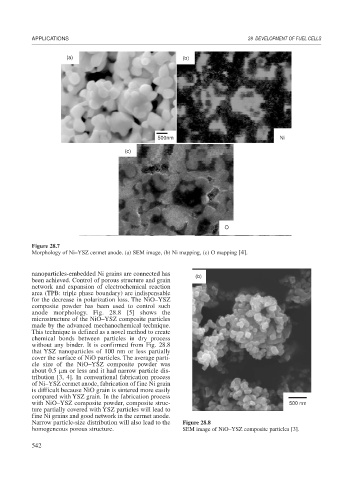Page 570 - Book Hosokawa Nanoparticle Technology Handbook
P. 570
APPLICATIONS 28 DEVELOPMENT OF FUEL CELLS
(a) (b)
500nm Ni
(c)
O
Figure 28.7
Morphology of Ni–YSZ cermet anode. (a) SEM image, (b) Ni mapping, (c) O mapping [4].
nanoparticles-embedded Ni grains are connected has (b)
been achieved. Control of porous structure and grain
network and expansion of electrochemical reaction
area (TPB: triple phase boundary) are indispensable
for the decrease in polarization loss. The NiO–YSZ
composite powder has been used to control such
anode morphology. Fig. 28.8 [5] shows the
microstructure of the NiO–YSZ composite particles
made by the advanced mechanochemical technique.
This technique is defined as a novel method to create
chemical bonds between particles in dry process
without any binder. It is confirmed from Fig. 28.8
that YSZ nanoparticles of 100 nm or less partially
cover the surface of NiO particles. The average parti-
cle size of the NiO–YSZ composite powder was
about 0.5 m or less and it had narrow particle dis-
tribution [3, 4]. In conventional fabrication process
of Ni–YSZ cermet anode, fabrication of fine Ni grain
is difficult because NiO grain is sintered more easily
compared with YSZ grain. In the fabrication process
with NiO–YSZ composite powder, composite struc- 500 nm
ture partially covered with YSZ particles will lead to
fine Ni grains and good network in the cermet anode.
Narrow particle-size distribution will also lead to the Figure 28.8
homogeneous porous structure. SEM image of NiO–YSZ composite particles [3].
542

